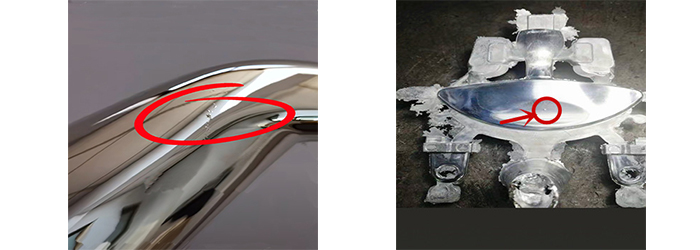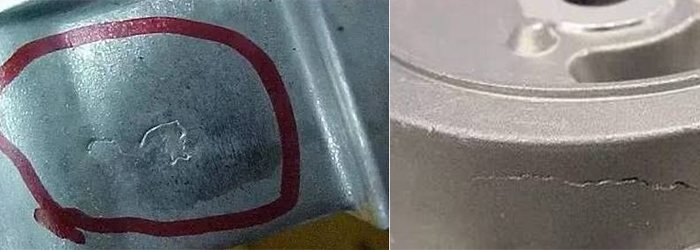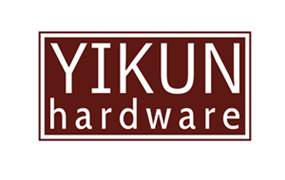Bubble formation in zinc alloy die-casting parts has long been a significant and common defect, troubling many die-casting professionals and manufacturing companies. Zinc alloy die-casting parts are widely used in various decorative applications, such as furniture fittings, building decorations, bathroom accessories, lighting components, toys, tie clips, belt buckles, and other metal decorative fasteners. Therefore, the surface quality of die-casting parts is highly demanding, requiring good performance in surface treatment. The most common defect in zinc alloy die-casting parts is surface bubbling.

1. Characterization of the Defect:
The surface of the die-casting part shows raised small bubbles, which are initially noticed during the die-casting process or revealed after polishing or further processing. Bubbles may also appear after painting or electroplating.
2. Causes of Bubble Formation:
1. Porosity :
● Porosity is caused by air pockets and shrinkage defects. Air pockets are usually round, while shrinkage defects tend to be irregular.
● Air pockets: These occur when gases from the cavity, volatile gases from coatings, or gases released during alloy solidification are trapped in the casting due to poor mold venting.
●During the filling and solidification of the molten metal, gas can become trapped, forming bubbles on the surface or inside the casting.
●Gases released from coatings can also infiltrate the casting.
● If the alloy has too much dissolved gas, it may precipitate during solidification, leading to the formation of air pockets.
● Shrinkage defects:
● Shrinkage occurs when the molten metal solidifies and contracts, and some areas of the casting fail to receive sufficient molten metal to compensate for the volume reduction, leading to shrinkage cavities.
● Castings with uneven thickness or areas of local overheating may solidify too slowly, causing certain regions to shrink and form indentations, which may result in shrinkage defects.
When porosity and shrinkage defects exist, water can seep into the pores during surface treatment. During painting or electroplating and subsequent baking, the trapped gases or water inside the pores expand due to heat, causing bubbles to form on the surface.

2. Intergranular Corrosion:
● Harmful impurities such as lead, cadmium, and tin in zinc alloys tend to accumulate at the grain boundaries, leading to intergranular corrosion. This weakens the metal matrix, and electroplating accelerates this process. The affected areas expand, lifting the plating layer and causing surface bubbling. Intergranular corrosion is particularly severe in humid environments, where it can cause deformation, cracking, or even breakage of the casting.
3. Cracking:
● Water marks, cold shuts, and hot cracks: When these defects occur, electroplating solutions can infiltrate the cracks. During baking, the trapped solutions turn into vapor, creating pressure that causes bubbles to form under the electroplating layer.
● Water marks and cold shuts: These defects arise when the molten metal cools and solidifies prematurely upon contact with the mold wall. The later-flowing metal fails to fuse with the already-solidified layer, creating visible marks or seams. Water marks typically occur near the surface, while cold shuts may penetrate deeper into the casting.
● Hot cracks: These occur during the late stages of solidification when the solidified metal structure begins to shrink. If this shrinkage is hindered, hot cracks can form.
● Hot cracks may occur if the casting has varying thicknesses, causing stress during solidification.
● Ejecting the casting from the mold too early, before it reaches sufficient strength, can also cause cracking.
● Excessive mold temperature can result in coarse grains at the grain boundaries, leading to cracks.
4. Improper Post-Processing:
● Polishing: The intensity of polishing, the type of polishing material (e.g., granite or ceramic stones), and the specifications of the equipment all affect the final result.
● Buffing: The specifications and intensity of the buffing wheels are crucial. Excessive intensity may damage the hard surface layer, while insufficient intensity may fail to achieve the desired polishing effect.
● Degreasing and Cleaning: During polishing or buffing, some auxiliary materials, such as wax or buffing liquids, may remain on the surface of the die-casting. These residues need thorough cleaning, typically with alkaline or acidic solutions, and electrochemical degreasing. Zinc alloy die-castings tend to have segregation during casting, with certain areas being richer in zinc or aluminum. Alkaline solutions dissolve aluminum, while acidic solutions dissolve zinc, which can cause pinholes that trap residues. These residues, when electroplated, can lead to bubbling on the surface. Therefore, cleaning and degreasing are crucial to preventing defects.
● Process and Storage:
● If castings are stored for extended periods after die-casting, they may absorb moisture and oxidize.
● Delaying plating after polishing or buffing can result in oxidation of the surface.
● Failure to electroplate immediately after degreasing and cleaning can lead to surface corrosion.

3. Solutions to Defects:
1. For Porosity:
● The key to reducing porosity is minimizing the amount of gas trapped in the casting. Ideally, molten metal should flow smoothly and consistently into the mold cavity. A well-designed gating system that accelerates the flow toward the injection gate and gradually narrows as it moves inward can help reduce turbulence and gas entrapment. Avoid sharp transitions in the gating system and ensure gradual changes in cross-sectional areas to prevent the metal from trapping air.
For Shrinkage Defects:
● To prevent shrinkage, ensure uniform cooling and solidification of the casting. This can be achieved through careful design of the runners, internal gate thickness, mold temperature control, and cooling systems.
2. For Intergranular Corrosion:
● Control the content of harmful impurities in the alloy, particularly lead, which should be kept below 0.003%. Strictly manage the use of recycled materials to prevent contamination with harmful elements.
3. For Water Marks, Cold Shuts, and Hot Cracks:
● Increase the mold temperature, adjust the injection speed, and add overflow slots or slag traps in areas prone to cold shuts to minimize these defects.
For Hot Cracks:
● Minimize stress imbalance during the die-casting process by adjusting processing parameters, reducing mold temperature, and lowering the zinc alloy melting temperature.
4. Post-Processing:
● Use appropriate abrasive sizes (0.045–0.069) for polishing and select the correct specifications for buffing tools.
● For rolling polishing, use granite ceramics with polishing liquid, and ensure the ratio of stones to products is 2.5:1. The polishing time should be 1.5–2.0 hours, with the rolling speed kept moderate to avoid excessive heat.
● Buffing should use yellow grease for coarse polishing and white paste for fine polishing. The cloth wheel speed should be moderate, especially for smaller parts. After polishing, protect the parts with white powder and keep them separated using soft materials before electroplating.
5. Cleaning:
● Use organic solvents, surface activators, or cold degreasing solutions for initial cleaning. Ultrasonic cleaning is the most thorough method to ensure no residues remain.
● After cleaning, the parts should undergo etching and activation to improve the adhesion of subsequent electroplating. Ensure that all solutions are pure, and maintain a clean environment in the cleaning tanks.
● Electroplating should occur within 12 hours after polishing, degreasing, and cleaning. Plated parts should be stored in a dry, ventilated area, protected from direct sunlight.
Conclusion:
The bubbling issue in zinc alloy die-casting parts is primarily caused by porosity, shrinkage defects, intergranular corrosion, cracks, and improper post-processing. By optimizing design, improving the casting process, and ensuring thorough cleaning and plating procedures, these defects can be minimized, thereby improving the surface quality and durability of the die-cast parts.
YIKUN, a professional furniture hardware supplier who is specialized in products such as: Cremone bolts, decorative knobs and pulls, caster wheels, furniture hinges, and furniture magnets etc. We are glad to inform you that we have opened our new office in February. We will continously support our customers as we always do.
Contact: Mr.Wang
Phone: 15907694600
E-mail: sales@yikun-hardware.com
Whatsapp:
Add: 1.Xiniubei Industrial Zone, Dalang Town, Dongguan City, Guangdong 2.18F BHC Central Center, No. 2218 Hunan Road, Pudong New Area, Shanghai
We chat